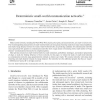Free Online Productivity Tools
i2Speak
i2Symbol
i2OCR
iTex2Img
iWeb2Print
iWeb2Shot
i2Type
iPdf2Split
iPdf2Merge
i2Bopomofo
i2Arabic
i2Style
i2Image
i2PDF
iLatex2Rtf
Sci2ools
IPL
2000
2000
Deterministic small-world communication networks
Many real life networks, including the World Wide Web, electric power grids, and social networks, are small-world networks. The two distinguishing characteristics of small-world networks are strong local clustering (nodes have many mutual neighbors), and small average distance between two nodes. Small-world networks are promising candidates for communication networks since typical data-flow patterns in communication networks show a large amount of clustering with a small number of "longdistance" communications that need to be completed quickly. Most previous research on small-world networks has used simulations, probabilistic techniques, and random replacements of edges to study the limiting behaviour of these networks. In this paper, we initiate the study of small-world networks as communication networks using graph-theoretic methods to obtain exact results. We construct networks with strong local clustering and small diameter (instead of average distance). Our networks hav...
| Added | 18 Dec 2010 |
| Updated | 18 Dec 2010 |
| Type | Journal |
| Year | 2000 |
| Where | IPL |
| Authors | Francesc Comellas, Javier Ozón, Joseph G. Peters |
Comments (0)

